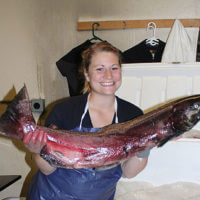Global hatchery production of all five species of Pacific salmon has increased in response to declining wild stocks and increasing pressures from sport and commercial fisheries. Modern hatchery regulations in Alaska identify the risks of hatchery production and state that hatcheries must contribute to common property fisheries while avoiding significant negative impacts to wild stocks. We reviewed the history of Alaskan hatchery policy and analyzed its ability to adequately address the adverse impacts of hatchery production. Given the variable nature of wild returns, and the stable level of hatchery production, there is cause for concern that the proportion of spawning hatchery origin fish in streams has exceeded the proposed maximum thresholds, potentially negatively impacting wild stocks. We also examined modern hatchery practices to mitigate for hatchery-wild genetic interactions by producing sterile, triploid Chinook salmon. Although optimal ranges of triploid induction parameters have been suggested, variability in triploidy success rates and survival through triploidy induction are typical outcomes, likely a strong reflection of maternal influences. The results of this study indicate that maternal effects do impact the survival rates of triploidized salmon, however we were unable to successfully assess triploid rates.
Current Status: GIS Analyst III for the Alaska Department of Fish and Game Commercial Fisheries Division (Juneau, Alaska)
Funding for this work was provided by the Pollock Conservation Cooperative via the Alaska Education Tax Credit Program.

